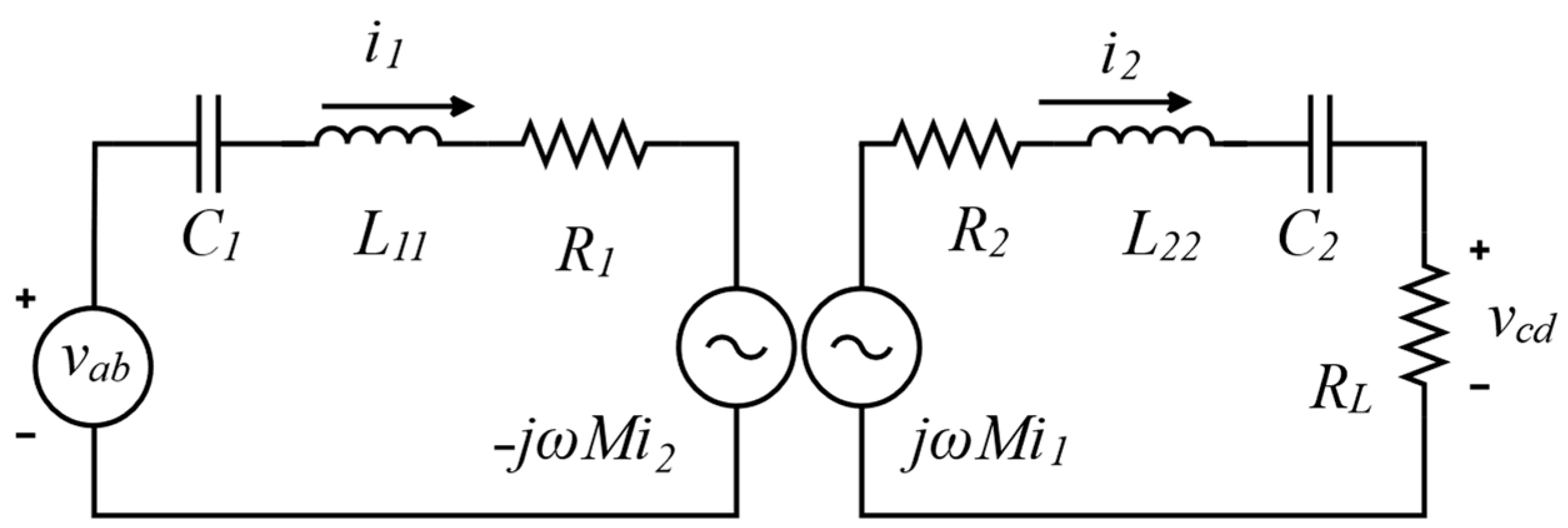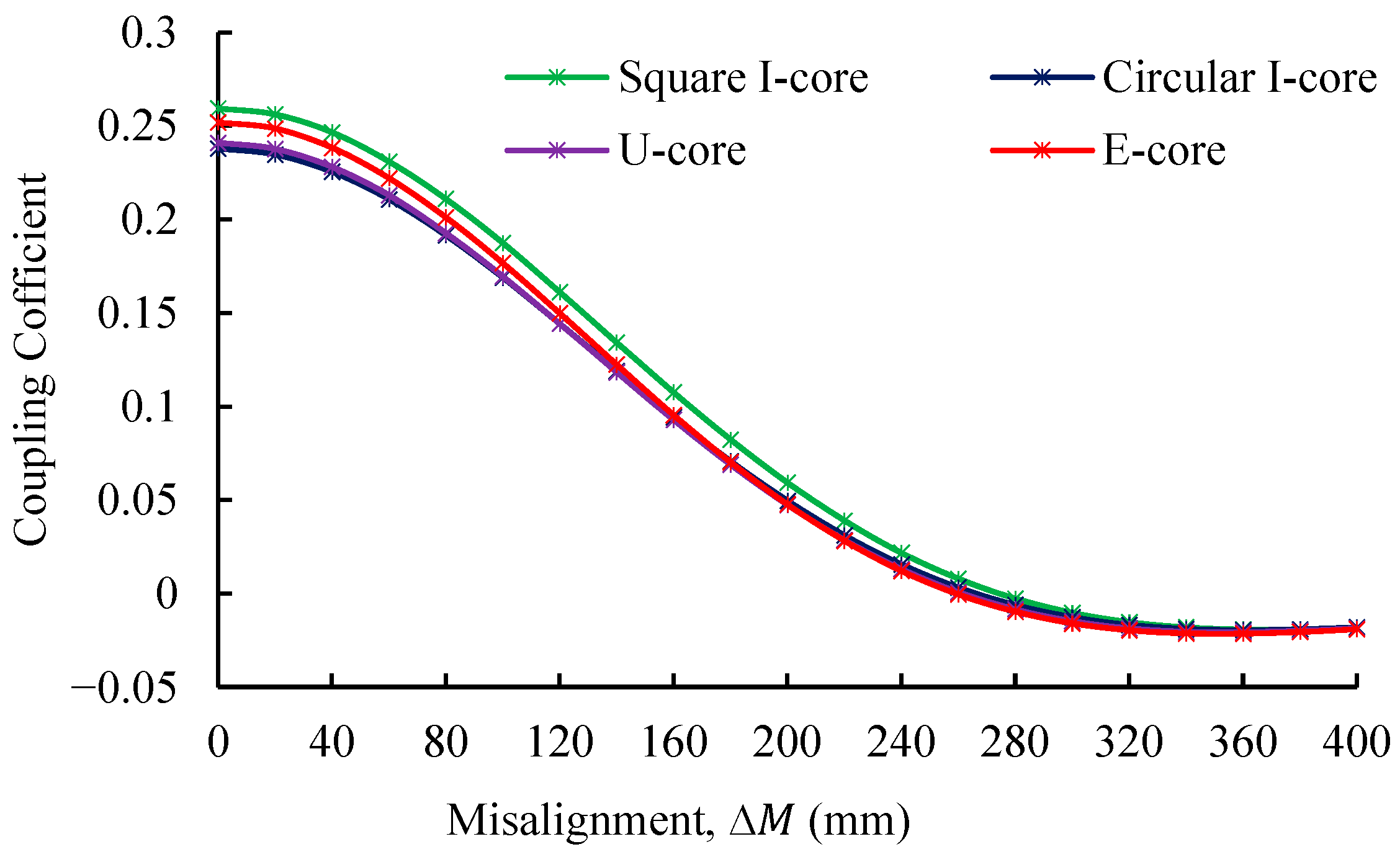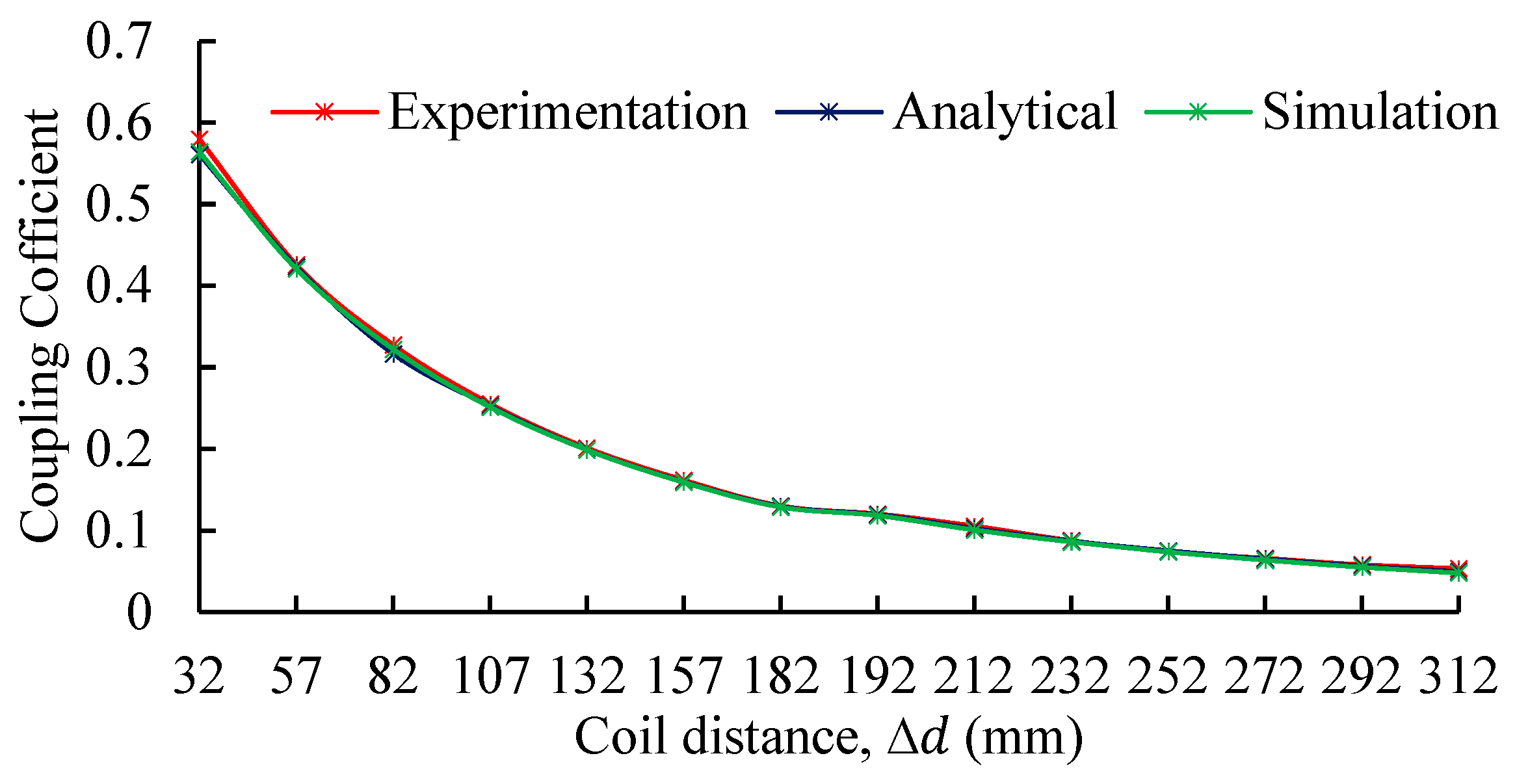Coupling Performance of Cored and Coreless Circular Coils for WPTS: Experimental Validation Under Misalignment Scenarios
Abstract
1. Introduction
2. Coil Design Considerations
- : The target output power in Watts (W).
- and : The RMS output and input voltages (V).
- : The equivalent load resistance (Ω).
- and : The RMS primary and secondary currents (A).
- and : The self-inductances of the primary and secondary coils (H).
- : The mutual inductance between the coils (H).
- and : The primary and secondary series compensation capacitances (F).
- : The angular resonant frequency (rad/s), defined as .
3. Analytical Estimation of Inductive Characteristics
3.1. Self-Inductance of Ring Coils
3.2. Self-Inductance of Spiral Coils
3.3. Mutual Inductance of Ring Coils
3.4. Mutual Inductance of Spiral Coils
3.5. Coupling Coefficient
4. Parameter Variation Analysis
4.1. Simulation Parameters
4.2. Validation of the Proposed Method
| Ring Coil | Required Values Based on (1)–(9) | Analytical (10), (13), (27) | Error % | FEM-2D | Error % |
|---|---|---|---|---|---|
| (µH) | 800.982 | 800.631 | 0.0438 | 801.0757 | 0.0116 |
| (µH) | 81.448 | 78.799 | 3.252 | 82.6629 | 1.4916 |
| (µH) | 51.083 | 52.48 | 2.734 | 51.5794 | 0.9705 |
| 0.2 | 0.2089 | 4.469 | 0.20044 | 0.220 |
| Spiral Coil | Required Values Based on (1)–(9) | Analytical (11), Ref. [7] | Error % | Analytical (12), (22) | Error % | FEM-2D | Error % | Experimentation | Error % |
|---|---|---|---|---|---|---|---|---|---|
| (µH) | 800.982 | 802.653 | 0.2085 | 794.0323 | 0.867 | 804.0198 | 0.3792 | 795 | 0.7469 |
| (µH) | 81.448 | 80.3651 | 1.3295 | 82.6138 | 1.4312 | 81.1902 | 0.3166 | 81 | 0.5501 |
| (µH) | 51.083 | 51.029 | 0.1053 | 51.101 | 0.0342 | 51.0526 | 0.0607 | 50.25 | 1.6319 |
| 0.2 | 0.2009 | 0.46071 | 0.1995 | 0.2403 | 0.1998 | 0.0914 | 0.198 | 0.9898 |
4.3. Examination of Inductive Characteristics for Coreless Coils
4.3.1. Effect of Turn Number and Turn Distance
4.3.2. Influence of Coil Placement and Misalignment on Coupling Coefficient
4.4. Examination of Inductive Characteristics for Cored Coils
| Core Type | Calculated Geometric Volume (mm3) | Total Estimated Weight (kg) | Total Estimated Cost ($) |
|---|---|---|---|
| Circular I-Core | 794,990 | 14.1 kg | $263.94 |
| Square I-Core | 1,012,500 | 17.9 kg | $335.79 |
| U-Core | 930,280 | 16.5 kg | $308.82 |
| E-Core | 1,065,800 | 18.9 kg | $353.64 |
5. Hardware and Experimentation Results
5.1. Experimental Validation Under Vertical Misalignments
5.2. Experimental Validation Under Horizontal Misalignments
5.3. Experimental Validation Under Angular Misalignments
5.4. Experimental Validation of Cored Structures
6. Conclusions
Author Contributions
Funding
Data Availability Statement
Conflicts of Interest
References
- Amjad, M.; Farooq-i-Azam, M.; Ni, Q.; Dong, M.; Ansari, E.A. Wireless charging systems for electric vehicles. Renew. Sustain. Energy Rev. 2022, 167, 112730. [Google Scholar] [CrossRef]
- Zhang, Y.; Zhou, H.; Shen, Z.; Xie, R.; Zheng, Z.; Chen, X. A Family of Self-Adaptive Interoperable Receivers Based on Multiple Decoupled Receiving Poles for Electric Vehicle Wireless Charging Systems. IEEE Trans. Power Electron. 2024, 39, 11794–11802. [Google Scholar] [CrossRef]
- Ghazizadeh, S.; Ahmed, K.; Seyedmahmoudian, M.; Mekhilef, S.; Chandran, J.; Stojcevski, A. Critical Analysis of Simulation of Misalignment in Wireless Charging of Electric Vehicles Batteries. Batteries 2023, 9, 106. [Google Scholar] [CrossRef]
- Liu, S.; Su, J.; Lai, J.; Zhang, J.; Xu, H. Precise Modeling of Mutual Inductance for Planar Spiral Coils in Wireless Power Transfer and Its Application. IEEE Trans. Power Electron. 2021, 36, 9876–9885. [Google Scholar] [CrossRef]
- Aydin, E.; Yildiriz, E.; Aydemir, M.T. A new semi-analytical approach for self and mutual inductance calculation of hexagonal spiral coil used in wireless power transfer systems. Electr. Eng. 2021, 103, 1769–1778. [Google Scholar] [CrossRef]
- Yıldırız, E.; Kemer, S.B. Novel semi-analytical method for mutual inductance calculation of the thin spiral disk coils. IET Electr. Power Appl. 2019, 13, 1607–1612. [Google Scholar] [CrossRef]
- Hussain, I.; Woo, D.K. Simplified Mutual Inductance Calculation of Planar Spiral Coil for Wireless Power Applications. Sensors 2022, 22, 1537. [Google Scholar] [CrossRef]
- Yıldırız, E. Optimal Design with Generalized Inductance Calculation for IPTs Using a Spiral Rectangular Coil Pair. Electric. Power Compon. Syst. 2022, 50, 1212–1222. [Google Scholar] [CrossRef]
- Khan, S.R.; Pavuluri, S.K.; Desmulliez, M.P.Y. Accurate Modeling of Coil Inductance for Near-Field Wireless Power Transfer. IEEE Trans. Microw. Theory Tech. 2018, 66, 4158–4169. [Google Scholar] [CrossRef]
- Pirincci, N.; Altun, H. A New Analytical Study on Mutual Inductance Calculations for Wireless Power Transfer Using Magnetic Vector Potential. IEEE Trans. Magn. 2022, 58, 8002714. [Google Scholar] [CrossRef]
- Wei, G.; Hao, L.; Zhang, Y.; Zhang, T. Completely Analytical Calculation of Inductance for Circular Coils With Bilateral Finite Magnetic Cores at Arbitrary Position in WPT Systems. IEEE Trans. Power Electron. 2024, 39, 6597–6602. [Google Scholar] [CrossRef]
- Shi, Z.H.; Qiu, Z.C. Modeling of mutual inductance between superconducting pancake coils used in wireless power transfer systems. In Proceedings of the 2018 IEEE International Conference on Applied Superconductivity and Electromagnetic Devices ASEMD, Tianjin, China, 15–18 April 2018. [Google Scholar] [CrossRef]
- Qian, L.; Chen, M.; Cui, K.; Shi, G.; Wang, J.; Xia, Y. Modeling of Mutual Inductance between Two Misalignment Planar Coils in Wireless Power Transfer. IEEE Microw. Wirel. Compon. Lett. 2020, 30, 814–817. [Google Scholar] [CrossRef]
- Zhang, X.; Quan, C.; Li, Z. Mutual Inductance Calculation of Circular Coils for an Arbitrary Position with Electromagnetic Shielding in Wireless Power Transfer Systems. IEEE Trans. Transp. Electrif. 2021, 7, 1196–1204. [Google Scholar] [CrossRef]
- Viqar, S.; Ahmad, A.; Kirmani, S.; Rafat, Y.; Hussan, M.R.; Alam, M.S. Modelling, simulation and hardware analysis of misalignment and compensation topologies of wireless power transfer for electric vehicle charging application. Sustain. Energy Grids Netw. 2024, 38, 101285. [Google Scholar] [CrossRef]
- Wang, F.; Yang, Q.; Zhang, X.; Chen, T.; Li, G. Enhancing Misalignment Tolerance in Hybrid Wireless Power Transfer System With Integrated Coupler via Frequency Tuning. IEEE Trans. Power Electron. 2024, 39, 11885–11899. [Google Scholar] [CrossRef]
- Seo, D.-W.; Liu, Z.; Stankiewicz, J.M. Analysis of the Wireless Power Transfer System Using a Finite Grid of Planar Circular Coils. Energies 2023, 16, 7651. [Google Scholar] [CrossRef]
- Zhu, K.; Kiourti, A. Partial Shielding to Improve Sensitivity of a Fully Passive Bio-Magnetic Signal Detection System. In Proceedings of the 2023 International Applied Computational Electromagnetics Society Symposium (ACES), Monterey/Seaside, CA, USA, 26–30 March 2023. [Google Scholar] [CrossRef]
- Wu, M.; Yang, X.; Chen, W.J.; Wang, L.L.; Jiang, Y.B.; Gao, Q.Q.; Yan, Z.C.; Yu, X.P. A Compact Coupler with Integrated Multiple Decoupled Coils for Wireless Power Transfer System and its Anti-Misalignment Control. IEEE Trans. Power Electron. 2022, 37, 12814–12827. [Google Scholar] [CrossRef]
- Zhang, P.; Saeedifard, M.; Onar, O.C.; Yang, Q.; Cai, C. A Field Enhancement Integration Design Featuring Misalignment Tolerance for Wireless EV Charging Using LCL Topology. IEEE Trans. Power Electron. 2021, 36, 3852–3867. [Google Scholar] [CrossRef]
- He, X.; Zeng, Y.; Liu, R.; Lu, C.; Rong, C.; Liu, M. A Dual-Band Coil Array With Novel High-Order Circuit Compensation for Shielding Design in EV Wireless Charging System. IEEE Trans. Ind. Electron. 2024, 71, 2545–2555. [Google Scholar] [CrossRef]
- Elbeshbeshy, A.; Rizk, M.; Kaddah, S. Analysis of Inductive Characteristics for various Helical and Spiral Coil Configurations supported by COMSOL Multiphysics. Mansoura. Eng. J. 2021, 46, 23. [Google Scholar] [CrossRef]
- Ibrahim, A.M.; Soliman, A.S.; Mohammed, O.A. Optimizing Wireless Power Transfer Systems for Improved Efficiency Through Geometric and Dimensional Alignments. In Proceedings of the 2024 IEEE International Conference on Environment and Electrical Engineering and 2024 IEEE Industrial and Commercial Power Systems Europe (EEEIC/I&CPS Europe), Rome, Italy, 17–20 June 2024; pp. 1–6. [Google Scholar] [CrossRef]
- Ibrahim, A.M.; Soliman, A.S.; Mohammed, O.A. Intelligent Geometric Alignment and Dimensions-Guided Approach for Design Optimization for Efficiency Improvement of WPT Systems. In Proceedings of the 2024 International Applied Computational Electromagnetics Society Symposium (ACES), Orlando, FL, USA, 19–22 May 2024; pp. 1–2. [Google Scholar]
- Chao, Y.H.; Shieh, J.J.; Pan, C.T.; Shen, W.C. A closed-form oriented compensator analysis for series-parallel loosely coupled inductive power transfer systems. In Proceedings of the PESC Record-IEEE Annual Power Electronics Specialists Conference, Orlando, FL, USA, 17–21 June 2007; pp. 1215–1220. [Google Scholar] [CrossRef]
- J2954_202010; Wireless Power Transfer for Light-Duty Plug-in/Electric Vehicles and Alignment Methodology. SAE International: Warrendale, PA, USA, 2020. [CrossRef]
- Sullivan, C.R.; Zhang, R.Y. Simplified design method for Litz wire. In Proceedings of the IEEE Applied Power Electronics Conference and Exposition–APEC, Fort Worth, TX, USA, 16–20 March 2014; pp. 2667–2674. [Google Scholar] [CrossRef]
- Wheeler, H.A. Simple inductance formulas for radio coils. Proc. Inst. Radio Eng. 1928, 16, 1398–1400. [Google Scholar] [CrossRef]
- Mohan, S.S.; Hershenson, M.D.M.; Boyd, S.P.; Lee, T.H. Simple, accurate expressions for planar spiral inductances. IEEE J. Solid-State Circuits 1999, 34, 1419–1420. [Google Scholar] [CrossRef]
- Akyel, C.; Babic, S.I.; Mahmoudi, M.M. Mutual inductance calculation for noncoaxial circular air coils with parallel axes. Prog. Electromagn. Res. 2009, 91, 287–301. [Google Scholar] [CrossRef]




























| Parameter | Symbol | Value |
|---|---|---|
| Input Voltage | 117 V | |
| Output Voltage | 46.6 V | |
| Output Power | 200 W | |
| Frequency | 85 kHz | |
| Load Resistance | 10.87 Ω | |
| Primary Current | 1.71 A | |
| Secondary Current | 4.29 A | |
| Primary Self-Inductance | 800.98 μH | |
| Secondary Self-Inductance | 81.45 μH | |
| Mutual Inductance | 51.0835 μH | |
| Primary Capacitance | 4.377 nF | |
| Secondary Capacitance | 43.044 nF | |
| Skin Depth | 0.2264 mm | |
| Strand Diameter AWG (38) | 0.102 mm | |
| Strands Number | 180 strands | |
| Conductor Diameter | 1.9 mm |
| Parameter | Symbol | Value |
|---|---|---|
| Turn Number | 5~50 | |
| Turn Distance | 0~4.5 mm | |
| Coil Distance | 20~400 mm | |
| Misalignment | 0~400 mm | |
| Angular Misalignment | 0~90 deg |
| Scenario | Key Parameter Varied | Typical Error | Maximum Error | (Sim vs. Exp) |
|---|---|---|---|---|
| Coreless: Vertical Misalignment | Vertical Distance (32–312 mm) | ~5.1% | 10% at 312 mm | 0.99978 |
| Coreless: Horizontal Misalignment | Horizontal Offset (0–130 mm) | ~2.7% | 6.07% at 130 mm | 0.99943 |
| Coreless: Angular Misalignment | Angular Offset (0–90°) | <6% up to 50° | High at 90° | 0.975207 |
| Cored: Horizontal Misalignment | Horizontal Offset (0–150 mm) | ~1.0% | 1.65% at 0 mm | 0.998136 |
Disclaimer/Publisher’s Note: The statements, opinions and data contained in all publications are solely those of the individual author(s) and contributor(s) and not of MDPI and/or the editor(s). MDPI and/or the editor(s) disclaim responsibility for any injury to people or property resulting from any ideas, methods, instructions or products referred to in the content. |
© 2025 by the authors. Licensee MDPI, Basel, Switzerland. This article is an open access article distributed under the terms and conditions of the Creative Commons Attribution (CC BY) license (https://creativecommons.org/licenses/by/4.0/).
Share and Cite
Ibrahim, A.M.; Mohammed, O.A. Coupling Performance of Cored and Coreless Circular Coils for WPTS: Experimental Validation Under Misalignment Scenarios. Batteries 2025, 11, 257. https://doi.org/10.3390/batteries11070257
Ibrahim AM, Mohammed OA. Coupling Performance of Cored and Coreless Circular Coils for WPTS: Experimental Validation Under Misalignment Scenarios. Batteries. 2025; 11(7):257. https://doi.org/10.3390/batteries11070257
Chicago/Turabian StyleIbrahim, Ahmed M., and Osama A. Mohammed. 2025. "Coupling Performance of Cored and Coreless Circular Coils for WPTS: Experimental Validation Under Misalignment Scenarios" Batteries 11, no. 7: 257. https://doi.org/10.3390/batteries11070257
APA StyleIbrahim, A. M., & Mohammed, O. A. (2025). Coupling Performance of Cored and Coreless Circular Coils for WPTS: Experimental Validation Under Misalignment Scenarios. Batteries, 11(7), 257. https://doi.org/10.3390/batteries11070257







